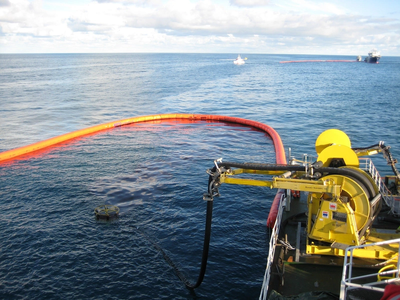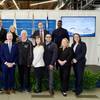Norwegian suppliers Framo, Maritime Partner, Norbit Aptomar, and NorLense have come together to create the OSRV (Oil Spill Recovery Vessel) Group to offer a complete oil spill response solution.
“Our aim is to be a one-stop-shop where we pool our efforts and act as a total systems supplier of safe, highly functional, and well-tested technology. The emergency response equipment has undergone thorough testing and quality assurance drawing on 40 years of oil spill response experience,” says Jørgen Brandt Theodorsen, Area Manager, Oil & Gas Pumping Systems, at Framo.
The OSRV Group offers a package solution that covers everything the customer needs, from detection and containment to recovery of the spill. All conducted with reliable equipment that can handle the challenges if an accident occurs.
Framo, Maritime Partner, Norbit Aptomar, and NorLense have come together, bringing their world-leading technologies to establish the OSRV Group – a “one-stop-shop” for oil spill response. The companies in this Norwegian cluster are all specialists in their particular fields. All the Norwegian-manufactured components have a dedicated function to achieve the best result possible. This also allows for conventional supply vessels to be converted to emergency oil-spill response support units.
All the technology just one phone call away
“The customer only has to deal with one of the partners to get access to a complete system that covers everything and is fully adapted in terms of functionality, volume and size.” Says Roy Arne Nilsen from the international sales team at NorLense.
Aptomar’s radar and infrared camera identifies and produces an overview of the oil slick, whereas Maritime Partner's powerful, high-speed vessels are perfect for pulling equipment such as booms in place. The oil is contained with booms from NorLense, and then recovered onto a vessel with the Framo TransRec Oil Skimmer System. This is equipment that is in use worldwide, and the technologies are tested annually as part of realistic drills.
Improved utilisation of tonnage
Although the market is gathering pace, there are many offshore vessels still laid up and without assignments.
“Oil spill response is a complex operation”, adds Lars Solberg, Sales and Marketing Director at Norbit Aptomar AS.
“This is a turnkey solution where customers have access to emergency preparedness expertise without themselves having to acquire this. With our package solution, supply vessels can easily be upgraded and used as part of new emergency response tenders. It is quick and easy for shipowners to convert existing vessels in order to offer new services to oil companies,” emphasises Solberg.
Short lead-time on delivery
“Going forward, delivery lead-times will be of utmost importance. When the assignments start ticking in, getting the mandatory equipment on board could become a time-critical issue. As the OSVR Group, we will ensure that an emergency oil-spill response system reactive, responding quickly.” Says Peder Myklebust, Managing Director of the boat-building specialist Maritime Partner.
By using OSRV Group, the operator is just one phone call away from a complete solution delivered at the right time.
“We operate with a delivery lead-time of a mere 8 weeks for the full package of Norwegian-manufactured, high-quality equipment.” Continues Myklebust.
Close dialogue and collaboration between the four manufacturers leave customers with first-class support and quality assurance at every level.
User-friendly
Handling of the equipment requires minimal manpower. This reduces the need for crew members, is cost-effective for the shipowner, and increases the safety level as there are fewer people involved. Thorough training of operators helps extend the lifespan of the equipment.
“When an accident occurs, oil recovery is a race against the clock. The sooner a spill is detected, the sooner it can be contained and managed. It will then be cheaper and safer to recover the spill as quickly as possible,” says Jørgen Brandt Theodorsen from Framo.
“Norway in a Nutshell”
The OSRV Group offers potential customers a round-trip in Norway, with visits to the suppliers in Bergen, Ålesund, Trondheim, and Lofoten. Customers also have the option to lease the equipment from OSVR Group. For Norwegian shipowners abroad, the GIEK financing scheme may be of help.
“Leasing is beneficial as is does not impact on the customer’s liquidity. Cash flow can often be a challenge, and leasing allows for vessels to be converted for new opportunities without the same level of funds available,” says Roy Arne Nilsen at NorLense.
The OSRV solution – facts & figures
In the event of an oil spill, Norbit Aptomar's radar performs the difficult initial task of detecting the spill on the surface of the sea. With this technology from the Trondheim based company, live data from the infrared sensor technology will establish the location of the oil slick, its size, its relative thickness, and in what direction it is heading. This provides an overview of the operation and helps decide where to navigate the vessel tasked with the deployment of booms and is also used to confirm that the oil spill has been contained.
The offshore booms from NorLense in Lofoten are designed to handle demanding challenges at sea. In 20 minutes, one person alone can deploy 400 metres of the world’s largest oil spill containment booms.
Maritime Partner’s high-speed vessels will smoothly and quickly pull the booms into the correct formation to achieve the best result possible. Furthermore, these highly efficient vessels built in Ålesund can be used by crew members for other tasks that may arise.
When the oil has been contained, everything is ready for the Framo TransRec system to start the pumps that have the capacity to clean the ocean for up to 400 000 litres of oil per hour. This is equivalent to 16 large road tankers being emptied of their cargo in 60 minutes. Such capacity is paramount in the event of an oil-well blowout.
“In an oil spill situation, every minute counts. Water and oil expand when mixed. Similar to a fire, a small oil slick can grow very large if not dealt with at an early stage. This may result in significant costs and environmental damage.
To ensure that valuable time is not lost when the supply vessel used for oil recovery is full, a tanker can be called in and the oil transferred via Framo’s TransRec system. This also prevents the operation from being interrupted. “Concluded Jørgen Brandt Theodorsen, Framo.











